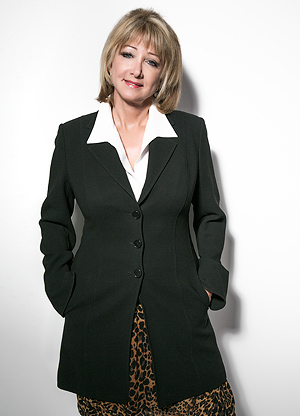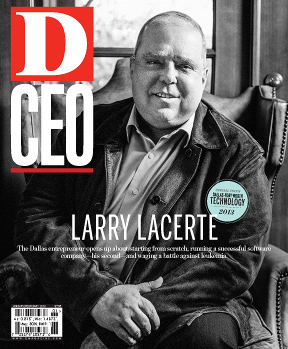The party room at Brook Hollow Golf Club was packed with Dallas real estate luminaries, there for the annual Stemmons Service Award event. Presented each December by the North Texas Commercial Association of Realtors, and named for Dallas real estate icon John M. Stemmons, it’s considered the highest honor in the industry.
Susan Arledge was seated front and center. The president of Arledge Partners was among the four nominees. She had been up for the honor a few times in the past, and jokingly referred to herself as “the Susan Lucci of the Stemmons Award.” Her sister, Brenda Sandoz of Allie Beth Allman Realtors, leaned over and asked if she had prepared an acceptance speech. When Arledge said she hadn’t, Sandoz told her she had taken the liberty of doing so, and pulled out a Post-it note that said, “Thank your sister.”
When her name was announced as the winner, Arledge looked truly stunned. It’s only the second time in the program’s 36-year history that the Stemmons Award has gone to a woman. (The first was in 2000, when Susan Gwin received the award.) Another surprise came when Arledge looked out at the crowd from the podium to see that her daughter Kelly, who’s interning as a biochemist in Beijing, had secretly flown back from China to join her brother, David, in congratulating their mother.
After composing herself, Arledge began her unscripted speech. Her remarks drew many laughs from the audience—especially when she talked about fellow nominee Gary Collett of Cushman & Wakefield, who was a football coach before getting into real estate. “He was the hottest football coach at my high school,” Arledge said. “Every sophomore girl hung out at the football practices—not for the guys, but to watch Coach Collett.”
She finished with a line from a song by “that great philosopher and orator” Garth Brooks: “Life is not tried, it’s merely survived, if you’re standing outside the fire.”
The truth is, Arledge has been standing in the fire ever since getting into commercial real estate more than 30 years ago.
Independent Nature
Arledge grew up in Dallas, attending Woodrow Wilson High School, where she was on the high-kick performance drill team. Her independent nature was cultivated early, after losing her father when she was just 14 years old. “I think anytime you grow up with without parental involvement, you become more self-sufficient and learn to do things for yourself—that forced maturity, if you will,” Arledge says.
At the University of Texas, Arledge majored in history, English, and math, not sure of the career she wanted to pursue. When a friend was admitted to UT’s law school, she thought she might like to become an attorney herself, and got a job as a paralegal for Sun Production Co., negotiating oil and gas leases and handling legal work associated with those deals. One day, her boss called her in and told her she had been doing a great job, and had earned a 4 percent raise.
“I did a quick calculation in my head to figure what a 4 percent annual increase would mean over the next decade and thought, ‘There has to be something better than this,’” she says. “I decided to try something that had more upside.”
It was the late 1970s, and Arledge had a few friends who were getting into commercial real estate. She thought she’d give it a try, too, thinking, “How hard can it be?” She pursued opportunities at firms throughout Dallas, but kept being told that she should “try residential.” Finally, she persuaded the late Dan Petty at Henry S. Miller to give her a chance. Office space at the firm was so tight, she worked from a desk in the middle of the hallway, before getting moved to an office in a storage closet, with a lightbulb hanging down from the ceiling.
She spent about a year in the industrial division, then shifted to the office sector after a run-in with a colony of bats at a Brookhollow warehouse, and after considering rent differentials. “Office buildings were just starting to be developed outside of downtown,” Arledge says. “Industrial rents back then were about $2 a square foot; office space was going for $7 or $8 per space foot.”
After a few years of that, she began talking with Roger Staubach, whom she’d run into while working out at the Cooper Aerobics Center. The former Dallas Cowboys quarterback and Henry S. Miller alum was looking to get out of a development partnership and launch a new firm that focused on tenant representation. “I went over there to help him start it up,” Arledge says. “Little did I know how controversial it would end up being.”
Tenant Rep Pioneer
The practice of tenant representation is commonplace today, but 30 years ago it caused an uproar when it was introduced to the market. In the past, brokers catered to the interests of the building owners, landlords, and developers that paid their fees. Staubach saw an opportunity to solely represent tenants, so there wasn’t a conflict of interest. It was a transformational period in the industry, and the timing was right.
Former Staubach Co. president Jim Leslie, now CEO of Cresa Partners, joined the firm early on as CFO. “I thought it was a great idea, but if you were to ask us 10 times what tenant representation meant, you’d probably get 10 different answers,” he says. “It was a concept; no one had defined it, which made it interesting as we were out selling our services.”
As much as the developers and building owners complained, they were the driving force behind the transition, Leslie says.
“The office market had been overbuilt, and Dallas landlords began getting creative with complicated deals, really setting up the need for our services,” he says. “Tenants needed someone to filter through all of the options. The overbuilding helped catapult us into getting clients and market share.”
Arledge says the tenant rep brokers were viewed as the enemy, and generated “a lot of cusses and complaints.” At one point, a group of the larger developers in town banded together and refused to do business with The Staubach Co.
“It’s not so much fun, being a pioneer and getting the arrows in your back,” Arledge says. “But just like Dan Petty, Roger is a man of vision and courage. He passionately believed that every party deserved the right to have their interests fairly represented, and fought against the tremendous outcries from the development community.”
There was a lot of suffering during the real estate downturn that followed the overbuilding, and developers felt the tenant reps were pushing too hard for concessions. But the tenant rep trend clearly wasn’t going away. A handful of industry leaders brokered a “peace accord,” and the bitterness eventually faded. There are some lingering resentments, Arledge says, but most of their previous opponents are now in the tenant representation business themselves.
After seven years at Staubach, she joined former Henry S. Miller colleague Dan Arnold to build a tenant rep group for Swearingen Co. She launched her own firm in 1993, again thinking, “How hard could it be?”
“That’s the beauty of naiveté,” Arledge says.
The company, Arledge Partners, focuses on tenant representation, with a specialty in site selection, labor analytics, and incentives negotiation. Many of its projects are for call centers and business process outsourcing facilities around the country.
It’s a growing specialty, Arledge says. “Most companies are no longer just making real estate decisions—labor costs are becoming the driver,” she says. “It’s becoming a huge opportunity, as evidenced by all of the big real estate firms developing their own site selection practice groups within their organizations.”
Leslie says his former colleague’s success is driven by her discipline, persistence, and organizational skills. “Before computers and smart phones, she had the most elaborate 3×5 card system I had ever seen,” he says.
“Susan is very focused on her clients—a lot of salespeople don’t have the ability to listen,” Leslie says. “And her tenacity goes well beyond what’s typical. But people don’t view her as a nag; she’s someone they enjoy hearing from. They just know she’s not going away. That polite persistence is a unique skill for people to have in any industry.”
Arledge puts it another way: “Successful people form the habit of doing what unsuccessful people don’t want to do.”
Despite “constant offers” from networks and larger commercial real estate firms, Arledge has chosen to remain “fiercely independent.” She says it allows her to choose the clients she wants, avoid internal conflicts sometimes seen at larger shops, and have more flexibility in how deals are structured.
After an “exceptional” 2012, she’s expecting an even stronger 2013, especially as demand for services in her area of specialty grows.
“I have no plans to retire,” she says. “I love what I do. That’s the fun part. If you can get up every morning and love what you do—how lucky are you?”






